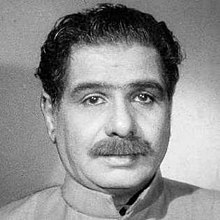
Back كيتور ناجاياه ARZ वुप्पलादादियम नगय्या Hindi V. Nagaiah ID チットゥール・V・ナガイアー Japanese சித்தூர் வி. நாகையா Tamil చిత్తూరు నాగయ్య Tegulu V. Nagaiah Uzbek
Chittoor Nagayya | |
|---|---|
 | |
| Born | Vuppaladadiyam Nagayya Sarma 28 March 1904 |
| Died | 30 December 1973 (aged 69) |
| Occupation(s) | Actor, composer, director, producer, writer and playback singer |
| Years active | 1938–1973 |
| Awards | Padma Shri (1965) |
Vuppaladadiyam Nagayya Sarma (28 March 1904 – 30 December 1973), popularly known as Chittoor Nagayya, was an Indian actor, singer, music composer, and director known for his works in Telugu cinema, Tamil cinema, and Telugu theatre. Nagayya was one of the first multilingual filmmakers in India.[1] Indian film journalist Baburao Patel described Nagayya as "The Paul Muni of India".[2][3] Nagayya was considered the best character actor in South Indian cinema during 1940s and 1950s.[2] In 1965, he became the first South Indian actor to receive the Padma Shri in Arts from the Government of India for his contributions to Indian cinema.[2][4][5]
Brought up in Chittoor, Nagayya was closely connected to Rama Vilasa Sabha, a Telugu theatre association in the city. He made his film debut in Gruhalakshmi (1938). He worked in several films of Vauhini Pictures such as Vande Mataram (1939), Sumangali (1940), Devata (1941), Swarga Seema (1945), and Beedhalapatlu (1947).[6] Nagayya was also the protagonist in Viswa Mohini (1940), the first film on the Indian motion picture world.[7]
Nagayya made significant contributions to Telugu cinema, and starred in about two hundred Telugu films.[8] He was a method actor, and his forte was usually playing intense characters, often immersing himself in the study of the real character's traits and mannerisms.[8] His other prominent film roles include the 14th-century poet Pothana in Bhakta Potana (1942), 17th-century saint Tyagaraja in Thyagayya (1946), 12th-century saint Gora Kumbhar in Chakradhari (1948), and Sivaram in the social problem film Naa Illu (1953).
In 1964, Nagayya essayed the 17th-century saint Bhadrachala Ramadasu in the film Ramadasu which he had also co-written, directed and produced. The film won the National Film Award for Best Feature Film in Telugu.[9] Nagayya also starred in about one hundred and sixty films in Tamil, Kannada, Malayalam, and Hindi.[5] In his honour, the Chittoor Nagayya Kalakshetram of Arts was established in Chittoor of Andhra Pradesh.[10]
- ^ "Nagaiah — noble, humble and kind-hearted". 8 April 2005.
- ^ a b c Muthiah, S. (23 May 2010). "Madras miscellany". The Hindu. ISSN 0971-751X. Retrieved 7 August 2022.
- ^ "Paul Muni of India – Chittoor V.Nagayya". Bharatjanani.com. 6 May 2011. Archived from the original on 26 March 2012. Retrieved 21 September 2011.
- ^ "Acting Mentor". The New Indian Express. Archived from the original on 27 March 2016. Retrieved 21 October 2014.
- ^ a b Autobiography – Chittor V. Nagaiah, RK Books, Hyderabad, 2004.
- ^ Amazon / Books / Indian actor Chittoor V. Nagaiah: A Monograph, by K. N. T. Sastry (Author)
- ^ "A revolutionary filmmaker". The Hindu. 22 August 2003. Archived from the original on 17 January 2004. Retrieved 23 April 2023.
- ^ a b "Chittoor Nagaiah statue to be installed in Tirupati". The Hindu. 18 July 2006.
- ^ "Chittoor Nagaiah statue to be installed in Tirupati". The Hindu. Chennai, India. 18 July 2006. Archived from the original on 5 August 2011.
- ^ Umashanker, K. (9 September 2014). "Mahati Kalakshetram to retain Chittoor Nagaiah's name". The Hindu.